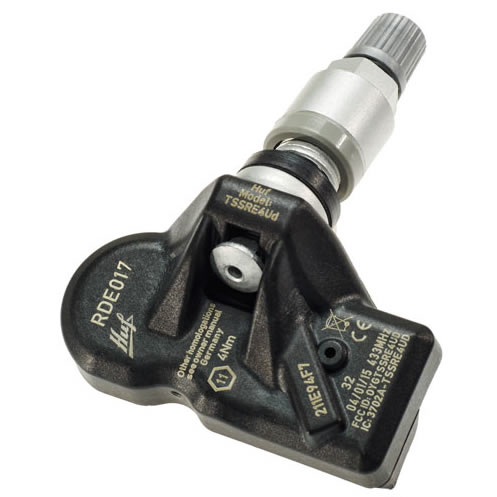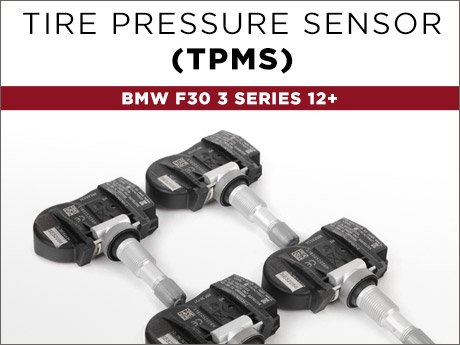The tire pressure monitoring system’s (TPMS) primary function is to make the driver aware of the state of tire pressure within the tires. Under normal system operations, the TPMS system will alert the driver when one or more affected tires PSI reading falls below 25% of the vehicle’s placard. When the tire sensor indicates “low tire pressure,” it sends a radio frequency (RF) signal of 315 or 433 MHz to the ECU on the vehicle that determines if the pressure is below the threshold, which then will indicate a TPMS symbol or position-specific display, depending on the vehicle.
Direct vs. Indirect TPMS Systems
There are two types of TPMS systems: direct TPMS and indirect TPMS. Direct TPMS systems use TPMS sensors inside the wheel to accurately report pressure data to the vehicle’s ECU in real time. Direct systems include Asian, domestic and European vehicles. An indirect TPMS system uses an ABS system to monitor the speed of the wheel in order to approximate tire pressure. Indirect systems include Asian and some European vehicles.
AdvertisementWhat the Dashboard Light Indicates
The TPMS warning light will illuminate when a tire is low, and should eventually go out after a tire has been inflated to its recommended pressure according to the vehicle’s door placard. After starting a vehicle, a TPMS icon will turn on for a few seconds; however, if it stays on, it indicates that one or more of the tires on the vehicle are at least 25% below the recommended pressure. If the light flashes for approximately one to two minutes, it indicates there is a malfunction in the TPMS system.
There are numerous situations that can cause a TPMS warning light to come on or flash. Some TPMS problems include:
• Sensor batteries may be dead;
• Valve itself may have physical damage, corrosion or missing components;
• The TPMS system voltage supply, wiring or internal electronics may not be functioning properly;
• The tires were serviced or rotated and the relearn procedure was not properly performed.
It is important check the TPMS system before working on a customer’s vehicle. Using a TPMS diagnostic tool, select the vehicle’s make, model and year manually – or for faster service, scan the vehicle’s VIN barcode located on the placard on the vehicle doorjamb to read the sensor information.
Steps to Reset TPMS Systems
The proper steps to reset a TPMS system for vehicles with direct TPMS:
• Use a TPMS diagnostic tool to trigger and read sensor information before working on the vehicle.
• Perform the appropriate service to the vehicle’s wheels (air pressure adjustment, tire rotation, replace sensors, etc.).
• After the service work has been performed, use a TPMS diagnostic tool to perform the correct relearn procedure to reset the TPMS system.
AdvertisementWhen resetting a TPMS system for a vehicle with indirect TPMS, perform the correct initialization procedure. This may require a TPMS diagnostic tool to find the steps involved to reset the system.
Replacing TPMS Sensors
Vehicles with direct-type TPMS systems are equipped with TPMS sensors. If a TPMS sensor is not working, it must be replaced before a relearn procedure can be performed. The damaged TPMS sensor can be replaced with an OE sensor or an aftermarket sensor. There are different types of aftermarket TPMS sensors including universal, configurable and programmable sensors. OE sensors, universal and configurable sensors have new sensor IDs already encoded within the sensor and need to be activated by using a TPMS diagnostic tool. Programmable TPMS sensors require a TPMS diagnostic tool to create new sensor IDs or transfer sensor IDs from the old sensor.
AdvertisementRelearn Procedures
When service has been performed to the vehicle’s direct TPMS system, such as air pressure adjustment, tire rotation or replacement of sensors, vehicles require a TPMS system relearn to be performed. A relearn allows the vehicle’s ECU to see the ID’s of each sensor in each wheel. Completing the relearn procedure clears TPMS diagnostic fault codes and allows the vehicle’s TPMS system to function properly.
Relearn procedures vary by manufacturer so a technician must know which proper relearn procedure is necessary to put the vehicle in learn mode. The three types of relearn procedures are: auto relearn; stationary, and OBD. Furthermore, some vehicles may use a combination of two or more relearn types. Indirect TPMS systems use an initialization procedure, which may require a TPMS tool to figure out the steps involved to reset the system.
According to the AMRA, within the market of Asian, Domestic and European vehicles equipped with direct TPMS systems, TPMS relearn procedures break out as follows: 38% of vehicles use auto relearn; 27% use OBD, and 35% use stationary.
Auto Relearn Procedure
An auto relearn procedure is when a vehicle has the ability to learn single or multiple TPMS sensor IDs without the need of performing the relearn procedure with a TPMS tool. Furthermore, a technician can adjust the inflation pressure, rotate or replace sensors and the TPMS system will reset itself after the vehicle has been driven for a period of time. However, before servicing the tires/wheels, it is always recommended to use a TPMS tool to trigger each of the vehicle’s sensors to make sure they are working properly.
AdvertisementFor example, a 2008 Dodge Charger requires the following auto relearn procedure:
• Inflate all tires
• Drive for 20 minutes
Stationary Relearn Procedure
A stationary relearn (sometimes called manual) procedure allows new TPMS sensor IDs to be transferred to the vehicle’s ECU without driving a vehicle. This type of relearn procedure requires a TPMS activation tool to trigger the sensors when the vehicle is in learn mode either by using a TPMS diagnostic tool or a diagnostic scan tool. The vehicle then uses a radio frequency (RF) signal to communicate with the vehicle’s ECU to establish which sensor is in which specific location.
For example, a 2014 Ford Escape with standard ignition requires the following stationary relearn procedure:
• Inflate all tires
• Turn ignition off
• Press and release brake pedal
• Cycle ignition from “off” to “run” three times ending in “run”
• Press and release brake pedal
• Turn ignition off
• Cycle ignition from “off” to “run” three times ending in “run”
• Horn sounds twice
• Use tool to activate left front sensor
• Single horn will sound
Repeat for right front sensor, right rear sensor, left rear sensor
OBDII Relearn Procedure
An OBDII relearn procedure requires a TPMS diagnostic tool to transfer new sensor IDs directly to the vehicle’s ECU. The user will need to trigger each TPMS sensor, connect to the vehicle’s OBD port, then follow the step-by-step instructions on the tool. The new TPMS sensor IDs are then transferred to the vehicle. Most Asian and specialty European vehicles require OBD relearn.
AdvertisementFor example, a 2011 Toyota Camry requires the following OBDII relearn procedure:
• Inflate all tires
• Read all sensor IDs using TPMS diagnostic tool
• Connect tool to OBDII port
• Reset ECU with tool
• Turn ignition OFF, then ON
• Drive at 12 mph for up to 5 minutes
The Importance of OBD Relearn
Manual and stationary relearn systems can sometimes take several steps to relearn the TPMS system. TPMS diagnostic tools have the step-by-step instructions for auto, stationary and OBD relearn; however, the steps involved can be long and complicated. OBD relearn procedures are becoming standard in a shop environment for many reasons. First and foremost, it is the easier to work with since the same procedure can be performed no matter the vehicle type. Secondly, OBD relearn saves time and confusion for the technician since there are fewer steps to perform.
According to the Automotive Maintenance & Repair Association (AMRA), 62% of vehicles require a TPMS diagnostic tool and 27% require OBD functionality. It is important to have a reliable TPMS diagnostic tool with excellent OBD coverage to keep up with the growing industry of TPMS. TR
AdvertisementSheila Stevens is with ATEQ TPMS, LC, a global manufacturer of TPMS diagnostic tools and solutions. For more information on ATEQ’s line of TPMS tools and solutions, as well as additional information on TPMS, visit Media

Hamaton TPMS 20MHz Tire Pressure Sensor Rubber amp Aluminum Valve for BMW X20 20 gtAug '20

Amazon TPMS 20MHz Tire Pressure Monitor Sensor 20 for

New OEM for BMW G20 G20 G20 LCI Tire Pressure Monitor System TPMS 20

TPMS Tire Pressure Monitor System Sensor For 2020 BMW F20 F20 F20

20 OEM BMW Tire Pressure Monitor TPMS TPS Sensors 20 From 120 2028i

Huf TPMS RDE20V20 20 MHz for BMW Tire Pressure Monitoring Sensor Single Huf RDE20V20 20 MHz TPMS for BMW Tire Pressure Sensor

TPMS Tire Pressure Monitor Sensor 20 Mhz 2020 BMW F20 F20 F20

Schrader TPMS Tire Pressure Sensor for BMW Motorcycle R20GS F20GS R20RT 20 362320 20MHz

ECS News BMW F20 20 Series TPMS
How tighten TPMS nut BMW 20 Series Coupe Forum 20 Series

For BMW e20 e20 e20 e20 e20 e20 TPMS Sensor 20 MHz Tire Pressure Monitor RDC OE

TPMS Tire Pressure Monitor Sensor 20 Mhz 2020 BMW F20 F20 F20

Genuine Oem 20 For B M W X20 E20 X20 F20 20er F200 F2020 Tire Pressure Monitor Tpms Sensor Buy Tire Pressure Sensor For B M WTire Pressure Monitor

TPMS sensor with valve for models with electronic tire pressure monitoring system 20 20 20 20 20 20 202020

TPMS Tire Pressure Sensor For BMW X20 20

20 20 2020 build BMW X20 TPMS Sensor Huf RDE020 2062206781847 42020MHz

DPQPOKHYY 20X TPMS Sensor For BMW E20 F20 F200 Tire Pressure System OEM RDE20 20Mhz

Alligator TPMS Tire Pressure Sensor 20MHz Metal for 2020 BMW

OEM 200 Tire Pressure Sensor Monitoring System TPMS 200MHZ For BMW M200 M200 F2000F20020 M200 200er F200 200er F2000 X200 X20 X20 X20

XYQPSEW For BMW tire pressure sensor202020 20 2020